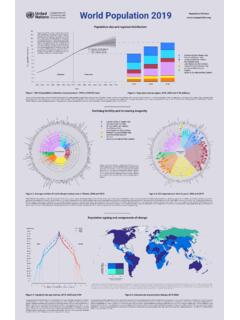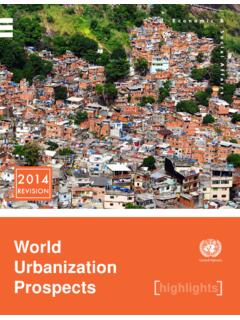Transcription of October 2017 No. 2017/3 The end of high fertility is near I
1 October 2017 No. 2017 /3 POPFACTS, No. 2017 /3 1 October 2017 n recent decades, developing countries around the world have been undergoing a demographic transition, characterized by increasing levels of life expectancy at birth and declining levels of lifetime fertility . Many of these countries are now reaching levels of mortality and fertility that are similar to those seen in the more developed countries. The total fertility rate for the world as a whole fell from around 5 live births per woman in 1950-1955 to births in 2010-2015. As a result of this global transition, an increasing share of the world s population now lives in countries where total fertility has fallen below the replacement level of approximately live births per woman over a lifetime; at this level of fertility , each generation of parents exactly replaces itself with an equivalent number of children who survive to adulthood, ensuring a long-term growth rate of Conversely, a relatively small proportion of the world s population now lives in countries with high levels of fertility conventionally defined as more than 5 live births per woman.
2 Given the projected future course of fertility , it is expected that this proportion will continue to decrease. Thus, the end of high fertility is near and should become a reality within the next decade or so, according to the results of the 2017 Revision of the World Population Prospects. 2 Figure 1 presents the distribution of the world s population by national levels of fertility in four time periods (1975-1980, 1995-2000, 2010-2015 and 2025-2030). Countries or areas have been divided into three groups according to their level of fertility in each period: - High fertility : more than 5 births per woman; - Intermediate fertility : from to 5 births per woman; - Below-replacement-level fertility : fewer than births per woman. Figure 1.
3 Distribution of the world s population by national fertility level in 1975-1980, 1995-2000, 2010-2015 and 2025-2030 1. The percentage of the world s population living in high- fertility countries has been declining rapidly In 1975-1980, close to a quarter of the world s population lived in countries with high levels of fertility as defined here. Twenty years later, in 1995-2000, the share of the global population that lived in high- fertility countries had fallen to 11 per cent. In 2010-2015, 8 per cent of the global population lived in countries where women were having, on average, more than 5 births over a lifetime. Starting in 2025-2030, it is expected that less than 1 per cent of the world s population will live in countries with such high levels of of global populationHigh fertility (more than 5 births per woman)Intermediate fertility ( to 5 births per woman)Below-replacement-level fertility (fewer than births per woman) IThe end of high fertility is near No.
4 2017 /3 POPFACTS, No. 2017 /3 2 October 2017 2 2. The percentage of the world s population living in countries with fertility at the replacement level or higher continues to fall In the period after 1975-1980, the decline in the number of countries with high levels of fertility could have brought an increase in the share of the world s population living in countries with intermediate levels of fertility . This was not the case, however, since there were also a number of countries where fertility fell from intermediate levels to below the replacement level. As a result, between 1975-1980 and 1995-2000, the share of the global population living in countries with intermediate levels of fertility declined from 56 to 45 per cent (figure 1).
5 Between 1995-2000 and 2010-2015, the overall decline of fertility was slower, and therefore the distribution of countries in each fertility group changed only slightly. In 2010-2015, the share of the global population living in countries with intermediate levels of fertility was equivalent, at 46 per cent, to the share living in countries where fertility was below the replacement level (figure 1). It is projected that in 2025-2030, only a third of the world s population will live in countries with fertility levels of at least births per woman. 3. Within 10 years, two thirds of the world s population are expected to live in countries where women will have fewer than births on average In 1975-1980, only 21 per cent of the global population was living in countries where fertility was below the replacement level.
6 In 2010-2015, 46 per cent lived in countries where women had, on average, fewer than births over a lifetime. With the continuation of fertility decline, as projected, for countries with fertility still above the replacement level, and with India, in particular, expected to move below the threshold of births per woman between 2025 and 2030, it is anticipated that by 2030 around two thirds of the world s population will live in countries where fertility lies below the replacement level. A few years earlier, between 2020 and 2025, it is projected that the world will reach another historic milestone. Those years will mark the first time when at least half of the global population will reside in a country where women will have, on average, fewer than births over a lifetime.
7 fertility trajectories as projected by the United Nations are based on the assumption that future changes in fertility will resemble past changes in both form and magnitude, taking into account any available data for each national population. Thus, the end of high fertility is in sight and will arrive soon, unless several countries follow unusual pathways and maintain higher levels of fertility in future decades compared to what is expected based on historical patterns of change. NOTES 1 The replacement level of fertility is close to live births per woman in populations with a normal sex ratio at birth (around 105 baby boys per 100 baby girls) and relatively low levels of mortality. It lies above that threshold in populations with an unusually high sex ratio at birth or relatively high levels of infant, child or maternal mortality.
8 2 The data used for this analysis are from United Nations, Department of Economic and Social Affairs, Population Division ( 2017 ), World Population Prospects: The 2017 Revision, New York: United Nations. The publication is accessible online (see ).
















